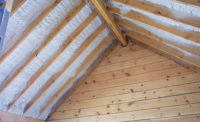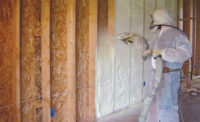Houlden Contractors is a Nebraska-based insulation and roofing business with a primary focus in the installation of spray polyurethane foam. Formerly involved in the region’s farming industry, owners Brad and Shirley Houlden founded their company—entering the contracting business—after economic factors in the 1980s placed deep pressure on the region’s farming community.
Brad notes, “I had hired a contractor to foam an agricultural facility a few years before and had always been fascinated by the performance of spray foam, which ultimately, is what drew me to the business.”
Ironically, the Houldens are still heavily tied to the region’s farming industry. A large portion of their projects are the insulation and roofing of agricultural facilities. With so many technological innovations in farming, crops are more plentiful and must be stored in cool, large temperature-controlled facilities prior to distribution.
Spray foam is an ideal solution for many of these buildings. In fact, business has been so strong for Houlden Contractors that they recently built a second facility from which to operate their business in the western part of Nebraska. Brad and Shirley Houlden oversaw both the design and build of their new facility, taking the best of other high performance structures and applying those concepts into their own building.
The Hybrid
Dubbed the “Houlden Contractors Western Division Headquarters,” the facility is a hybrid, mixed-use structure, which fulfills three key functions: warehouse, workshop and residence. Brad notes that, “The entire structure was designed around the use of spray polyurethane foam insulation in the walls and ceilings. With the use of SPF, we could simply do things size and height-wise with this structure that we never could have done had we used an alternative insulation.”
The commercial (workshop and warehouse) parts of the building comprise the larger portion of the project installation, representing 17,200 square feet, while the residential portion represents 5,000 square feet. Eaves in the facility are 18 feet in height. The total project installation represents 23,200 square feet.
Houlden Contractors selected Lapolla FOAM-LOK 2000 4G closed cell spray foam insulation, manufactured by Icynene-Lapolla, for the structure. The Houldens note that the manufacturers are always supportive and that their products stay “on top of the curve” chemically. Brad adds that, “their product is really great and, quite frankly, we really like our rep, Jeff Smith, because he is fantastic to work with.”
Installation Complications
With the facility’s multiple uses and larger size, the spray foam insulation installation itself proved complicated for the Houlden Contractors crew. The 18-foot eave height had been determined by the Houldens’ desire to create a 1,500-foot loft within the residence portion, which also made the use of lifts mandatory for this installation.
Additional complications with the installation centered around the fact that the commercial portion differs structurally from the residential portion. The shop and warehouse comprise an all-metal structure. The residential portion of the structure, however, is not all metal. While the exterior skin of the residence is in fact steel, there is a “wood pole” (i.e. 2 x 6 wood) construction on the interior. Brad notes that it was both easier and more cost effective to build the residential portion of the facility in this manner.
The all steel shell structure was built first, and then the commercial side of it was insulated with the closed cell spray foam insulation. Once this portion of the SPF installation was complete, it allowed the Houldens to store all building materials for the home within that commercial side of the building, out of the weather and protected from the elements. A lot of the construction and SPF installation occurred during the winter when severe cold was common, thus storing those materials indoors was imperative. The completion of the commercial side first also allowed the Houlden Contractors crew and other trades to keep working on the residence portion during wintertime.
Next, the home portion was built inside the steel shell. The lifts were brought in prior to installation of the interior walls (the height is why it was imperative to bring in the lifts first). The lifts were necessary as they brought the installers high up, giving them the ability to spray the underside of the roof with 6½ inches of the Lapolla FOAM-LOK 2000 4G closed cell spray foam. Next the interior walls were constructed, and plumbing, wiring, etc., were installed before the exterior walls were insulated with the spray foam. Additionally, urethane board stock was installed under the floors throughout.
The Real Cost
Aside from the spray foam being the first design specification for the facility, the second was that the structure would support aging-in-place, which is important to the Houldens who are currently planning their retirement. All doors, as well as the master bath and shower, are large enough for wheelchairs. No thresholds exist once you enter the front door. The Houldens have researched the cost of senior care facilities.
“In Nebraska, it costs anywhere between $7,000 to $10,000 monthly for one person to reside in a care facility. If we can stay in the house longer, because it’s been designed for aging, we can lower our eventual costs that way,” says Brad.
An additional, highly important component of the facility is its fire wall, which safely separates the commercial from the living space portion of the facility. A two-hour rated fire wall with IBC fire wall code certification, the wall protects the structure, its workers and its inhabitants.
Designed to prevent flames from spreading from one side of the building to the other for two hours or more, the wall is comprised of 2x6 construction and includes 5/8 fire-rated drywall on either side with two inches of Lapolla FOAM-LOK 2000-4G sprayed into the wall, acting as a total air seal. Fifteen mils of Lapolla FIRE-LOK Thermal Barrier was also applied to the wall and is covered with white paint. The material is a single-component, single application spray or roller applied protective coating for use in ignition barrier or thermal barrier applications in combination with spray foam insulations. In addition to being built to IBC fire wall code standards, the local fire chief also signed off on the wall’s safety.
Impressive Results
Brad Houlden explains that he and Shirley wanted this facility to be safe and to demonstrate the incredible performance of spray foam. The latter is significant for them, considering the business they are in.
“We have had a lot of looky-loos come by to visit the structure to see for themselves how it was designed and built,” says Brad Houlden. “Many are looking for ideas on how to improve their own homes and facilities and enhance how they are living and working. All are shocked and impressed with our incredibly low energy bills.”
During the initial construction phase, the local gas company laid a half-mile of pipe in two-inch diameter size to the structure, believing a pipe of that size would be required to keep a structure of this magnitude properly heated. The gas company has since admitted they overshot the pipe needs because the energy efficiency of the structure has far outperformed their expectations. Energy bills monthly, in the dead of winter months which span October through March, come in very impressively under $100, despite significant regional winter temperature drops, high winds and the building’s incredible size. Energy affordability, however, was a primary goal of the structure’s design. In comparison, a neighboring workshop structure, which is less than 8,000 square feet and insulated with fiberglass, has energy bills which regularly exceed $250 per month. “That neighbor has indicated on numerous occasions that he is envious of the performance of our facility, which makes us proud,” says Brad.














